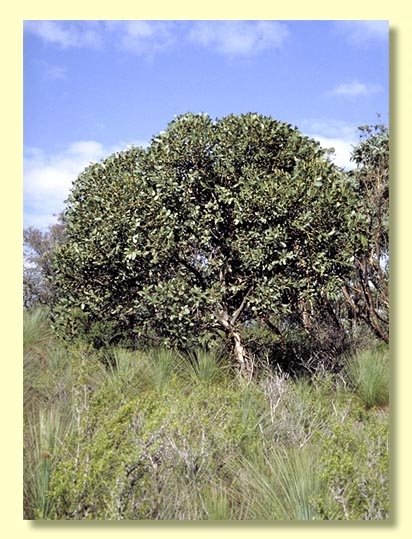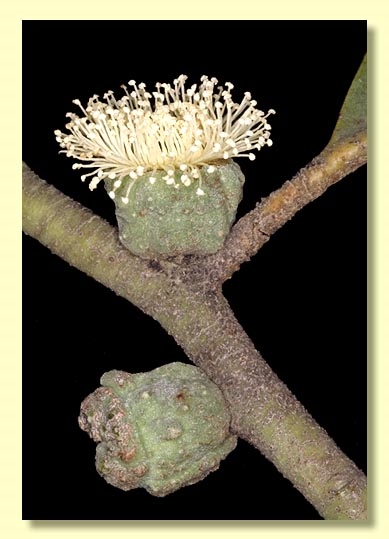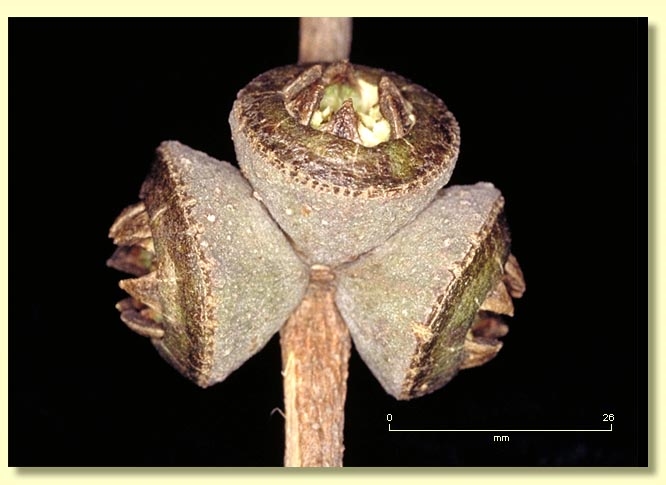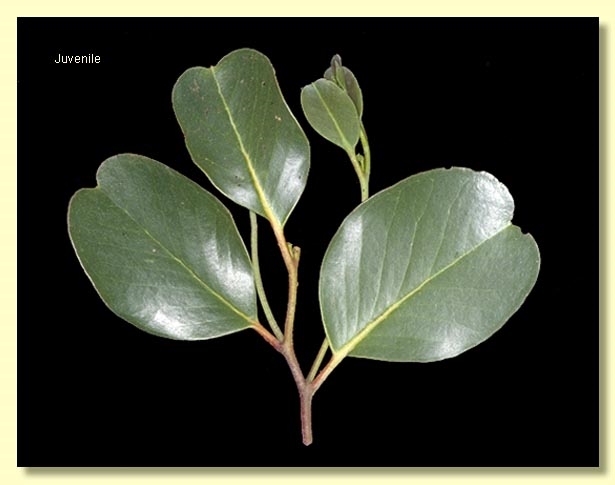Euclid - Online edition
Eucalyptus verrucata
Eucalyptus | Eucalyptus | Capillulus | Pachyphloius
Eucalyptus verrucosa Ladiges & Whiffin, Austral. Syst. Bot. 6: 367 (1993), nom. illeg. T: Grampians Vic. SE side of Mt Abrupt, alt 400 m, 30 Oct. 1979, J.C.Marginson 181; holo: MEL; iso: MELU.
[Eucalyptus alpina Lindley in T.L.Mitchell, Three Exped. Inter. Eastern Australia 2: 175 (1838). T: Summit of Mt William, Vic., July 1836, T.L.Mitchell 243; holo: CGE. This type specimen represents a plant of intermediate character between E. baxteri and [we presume] one or other of the taxa now known as E. serraensis and E. verrucata; for further information see Ladiges and Whiffin, Austral. Syst. Bot. 6: 365–6 (1993).]
Bark smooth throughout or, on larger plants, rough, hard, fibrous, finely fissured and greyish brown on base of trunk; smooth bark bronze-brown to greyish white.
Juvenile growth (coppice or field seedlings to 50 cm): stem rounded in cross-section, scabrid until about node 6 or 7; juvenile leaves opposite, sessile, broadly ovate, amplexicaul, discolorous, the lamina thin with a wrinkled or 'bubbly' appearance and scabrid for ca 6 or 7 nodes, then becoming alternate, oblong to ovate or obcordate, 6–10.8 cm long, 4–8.3 cm wide, base truncate to rounded or tapering, concolorous, glossy, green, glabrous and rather thick with rounded or emarginate apices.
Adult leaves alternate, petiole 1.2–2.8 cm long; blade ovate to elliptical, obovate, orbicular or oblong, 5.5–12 cm long, 2.5–9 cm wide, base oblique or tapering to petiole, concolorous, glossy, green, thick, side-veins at an acute or wider angle to midrib, sparsely to moderately reticulate, intramarginal vein parallel to and well removed from margin, oil glands island or obscure.
Inflorescence axillary unbranched, peduncles 0–0.2 cm long, buds in umbels of 1, 3 or rarely 7, sessile. Mature buds usually oblong to globular, 1–1.8 cm long, 0.8–1.4 cm wide, green, grossly warty, slightly angled longitudinally, scar absent, operculum rounded to flattened, stamens irregularly flexed or inflexed, anthers reniform to cordate, versatile, dorsifixed, dehiscing by confluent slits, style long, stigma tapered, locules 4–6 each with 2 vertical ovule rows. Flowers white.
Fruit sessile, cup-shaped or hemispherical, 1.2–2 cm long, 1.6–3.2 cm wide, disc raised-annular or level, valves 4–6, strongly exserted.
Seeds black or brown, 2–3.5 mm long, pyramidal or obliquely pyramidal, dorsal surface smooth, hilum terminal.
Cultivated seedlings (measured at ca node 10): cotyledons reniform; stems rounded in cross-section, stellate-hairy until ca node 6 or 7 then smooth; leaves sessile, opposite, discolorous and stellate-hairy until node 6 then becoming alternate, glabrous and concolorous, cordate to ovate, 5–9 cm long, 4.5–6 cm wide, base amplexicaul at first becoming rounded at upper nodes, margin irregular to entire, apex pointed to rounded and apiculate, bright glossy green and glabrous.
Flowering has been recorded in September.
A shrub or small tree confined to rugged, rocky sites in the Grampians of western Victoria on the southern end of the Serra Range, e.g. Mt Abrupt. Eucalyptus verrucata has smooth or sometimes hard fibrous rough bark, a crown of glossy green thick-textured leaves, grossly warty sessile oblong buds in one, threes or rarely sevens, and fruit 1.6–3.2 cm wide. Juvenile growth scabrid/hairy on lower stem and leaves but becoming glabrous, thick-textured and glossy green with rounded or notched tips.
Eucalyptus verrucata is related to two other Grampians endemic species, E. serraensis and E. victoriana, and to the more widespread E. baxteri. Eucalyptus serraensis has buds in clusters of three or seven and they are smaller than in E. verrucata, whilst its fruit are 1–2 cm wide. Also E. serraensis has firm rough bark throughout. Both E. serraensis and E. verrucata ultimately develop glabrous thick-textured juvenile leaves with rounded or notched apices and these leaves persist into the adult crown. Eucalyptus victoriana, endemic to the Victoria Range in the western Grampians, differs in being a moderately tall tree with distinctly stringy bark over the lower trunk and smooth-barked upper trunk and branches, a glossy green crown of thickish leaves with rounded to pointed apices, axillary clusters of 7 to 11 sessile, more or less angular and quite warty buds, and fruit 1–1.4 cm wide and with a prominently raised disc.
Eucalyptus baxteri is a taller tree differing in always having distinctly stringy bark throughout, thin-textured adult leaves, axillary clusters of > 7 minutely warty buds, more rounded fruit.
MORE ABOUT STRINGYBARKS












